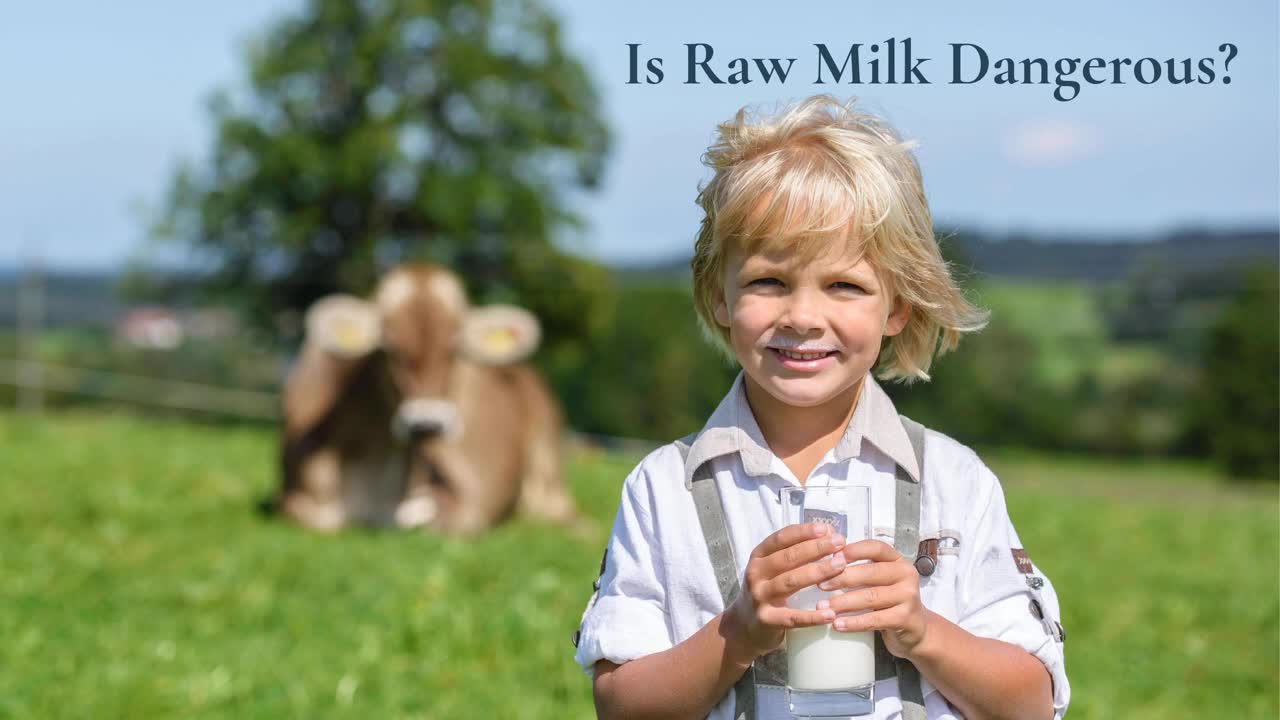Premium Only Content

Is Raw Milk Dangerous?
Is raw milk dangerous is a question that many are asking. There is a surge in desire for this luscious and nutritious food – but what about all of the horrible stories of tragedies and loss connected with consuming raw milk? That’s our topic of the day.
But first, I want to welcome everyone who is a new listener. I hope you enjoy this content. And as always, a heart-felt welcome back to the veteran homestead-loving regulars who stop by the FarmCast every week. I appreciate you all so much. There is no show without you and your input. There is a lot of exciting news to share with you about what is going on at the farm this week. So, let’s get to it.
Today’s Show
• Homestead Life Updates
• Is Raw Milk Dangerous?
• Lamb Chops with Balsamic Reduction
Homestead Life Updates
We had quite the scare last night. All of a sudden, we had no water. Scott went to the tap, turned it on, and only a dribble came out. Less than two hours earlier I remembered filling my water glass with no issues. He immediately went out to check on the water hoses. We have quite of few of them attached at the pump that bring water to various areas of the homestead. Some go to the animals and one goes to the garden. I think there may be one in the orchard. At least one other is attached to the house. These are the usual culprits. One of them will burst or a coupling disintegrates and falls apart spewing gallons and gallons of water everywhere. If we don’t notice right away, the well can temporarily go dry.
In this case, Scott checked all of the hoses and didn’t find any issues. He turned them off anyway. The next plan was to replace the breaker for the well pump. It is on its own 220 circuit. However, some time during the night the water returned. We are grateful. It was an interesting experience.
Usually when we don’t have water it is because the power if off. Habitually I would want to turn on the water and had to remind myself that we had none. When we have no power, it’s easy to remember we also have no water. It was a really strange brain thing.
Let me give you an update on the animals.
The Quail
We have 6 baby quail in the brooder at the moment. There were originally 8 but we lost two. This particular batch of eggs was not very fertile. As the amount of light diminishes each day due to the changing of the seasons, the number of eggs laid and their fertility drops dramatically. I knew it would drop. However, the amount that it dropped was astounding to me. I expected the loss of egg production, not so much the lack of fertility. So often, even though we’ve read up on a topic and have the proper information, it is not until we go outside those boundaries ourselves do we realize the truth of the information.
Back in the summer, we had 8 or 9 laying hens that were producing about 7 eggs per day. Not bad. That’s nearly one per day for each hen. That’s typical. A little over a month ago we added a new batch of young hens to the mix. They were about 8 weeks old and at the age to start laying eggs. Our daily haul should have increased. Unfortunately, this was also about the time that the light started really diminishing. At the present time having increased the laying hens to 15 laying hens, we are getting 1 egg every day or so. That’s what I call a dramatic drop in egg production. It will continue all winter unless we add some light for them. We have a plan there. I’ll let you know how it goes.
The Cows
Cloud is still pregnant. Her belly is very big in circumference, but there is no way of knowing how far along she is unless we get a vet out here. A woman can start to “show” in the 4th or 5th month, it begins to be impossible to miss that she is pregnant at 6 months and the 7th through 9th month is where stretch marks are developed because of the rapid growth in the size of your baby. With cows, the late development of size and weight of the fetus is even more prominent. While a calf fetus is continually growing in size throughout the pregnancy, it is slow in the beginning. Over 75% of the calf’s total weight gain and growth takes place in the last trimester. And like human women, that is in month 7 through 9. A cow’s gestation cycle averages 283 days. I’m guessing that Cloud is in her last month at this point. I could be wrong but that is my best guess.
In any case, we are ready in the milking parlor. She is now trained to come in and stand quietly while we wash and clean her udder like we would any other cow. The only thing she is not experiencing at the point is the actual inflations on her teats. She has heard the sound of the machine over and over many times. We do not anticipate big problems when the event does eventually take place.
The Sheep, Goats, and Donkeys
The sheep, goats and donkeys are doing well. The goats go into any grazing paddock that they choose – no matter the fencing structure. They are goats. Respecting fences is not part of their nature. Thank goodness at this point, while they move between divided paddocks, they at least stay within the perimeter fencing. I should probably knock on wood with that statement.
The sheep are plugging along. Let us know if you are interested in grass-fed and finished lamb. We are just about ready to take a few for processing. Holiday season is upon us and lamb is a religious tradition for lots of folks. Again, let us know. You can visit the website at peacefulheartfarm.com/store or send us an email (melanie@peacefulheartfarm.com).
The donkeys are growing their winter coat and putting on some winter fat. They are the friendliest animals on the farm. I hope you get to come out and see them some time.
The Creamery
The inner walls are rising out of the dust. It won’t be long now. Scott has laid the bottom row of the remaining walls. Two or three more weeks and they will be complete. It will be a building with walls and no roof. Is winter the best time to build a roof? I don’t know I’ll have to ask Scott. I’m just so excited to see these walls. The rooms are now defined.
In the spring perhaps we will be able to milk the cows in the new barn and milking parlor. That will be a treat. Milking is such a peaceful time and the milk produced is so nutritious and delicious. And the cheese… yum, yum.
Is Raw Milk Dangerous?
This is a question I think everyone who consumes raw milk has asked themselves or others. We know the reality is that we have been drinking milk straight from the cow for thousands of years. But in September 1987 it became federal law that any milk transported across state lines must be pasteurized. Intrastate sales then and now are still regulated by the individual states. I’ve talked a bit about this in a couple of previous podcasts. Depending on the particular State, there are various legal ways to obtain raw for your family.
There has been – and indeed continues to be – quite the scare campaign surrounding the consumption of milk straight from the cow. Each person will have to decide for themselves what is best for them. I make no judgements and everyone knows I love it. In fact, I love it so much that it can become a problem for my waistline. But let’s get to the studies and the data and see what we can see.
The Studies and the Headlines
In February 2012, the Center for Disease Control (CDC) published a study targeting raw milk as dangerous and unsafe for human consumption. The media hype surrounding it was typical. Fearful headlines that get clicks and sell papers were seen. Here are some examples:
“Raw Milk Causes Most Illnesses from Dairy, Study Finds.” – USA Today
“CDC: Raw Milk Much More Likely to Cause Illness.” – Food Safety News
“Raw Milk is a Raw Deal, CDC Says.” – LiveScience
Two of these headlines are technically accurate – raw milk is responsible for more illnesses than pasteurized milk when the number of people who consume each is taken into account. The problem begins with the dramatic overstatements and sensationalism of the findings. Every food we consume comes with risks. But for most, we never even think about it until we see the news article about the recall of spinach, beef or some other product we have in our refrigerator.
If you only saw the headlines from the CDC and FDA reports, you’d be left with the impression that raw milk is a dangerous food and anyone that consumes it or gives it to their children is reckless and irresponsible. In this podcast, I’ll present the other side of the argument, and give you the bare facts as I see them. I can’t say I am without bias but I will endeavor to convey the information without dramatic hyperbole so you can make an informed decision about whether unpasteurized milk is a good choice for you and your family.
I’m not here to convince you to drink raw milk. Again, that’s a decision each individual has to make on their own by weighing the potential risks against the potential benefits. This podcast will cover the risks and another will focus on the benefits.
Gaining Perspective
Let’s start with putting the current discussion of unpasteurized milk safety into a wider context. Foodborne illness is a concern for many types of food. In 2008 the Center for Science in the Public Interest (CSPI) performed a review of foodborne disease outbreaks in the U.S. Seafood, produce and poultry were associated with the most outbreaks. Produce is responsible for the greatest number of illnesses each year (2,062), with nearly twice as many illnesses as poultry (1,112). Dairy products are at the bottom of the list. They cause the fewest outbreaks and illnesses of all the major food categories – beef, eggs, poultry, produce and seafood.
According to the CDC, during the period from 1990 − 2006, there were 24,000 foodborne illnesses reported each year on average. Of those, 315 per year are from dairy products. This means dairy products account for about 1.3% of foodborne illnesses each year. That’s not exactly an alarming number, considering that more than 75% of the population consumes dairy products regularly.
It’s also important to note that the outbreaks and illnesses associated with dairy products are generally mild compared to other foods.
According to the CSPI report above, approximately 5,000 people are killed every year by foodborne illness. From 2009 − 2011, three high profile outbreaks involving peanuts, eggs and cantaloupe alone accounted for 2,729 illnesses and 39 deaths. (1) Yet there have only been a handful of deaths from pasteurized dairy products in the last decade, and there hasn’t been a single death attributed to raw fluid milk since the mid-1980s, in spite of the fact that almost 10 million people are now consuming it regularly.
The takeaway is that thousands of people are killed each year by foodborne illness, but they’re dying from eating fruits, nuts, eggs, meat, poultry, fish and shellfish – not from drinking unpasteurized milk.
The CDC report Sensationalized
The data in these studies will always be suspect in my mind. An “illness” in these data can mean everything from an upset stomach to mild diarrhea to hospitalization for serious disease. Most food borne illnesses go unreported and one of the reasons is that they are only a passing nuisance.
Have you ever had a bout of diarrhea that you suspect was caused by something you ate? I have. Did you report it to your doctor or the county public health department? Probably not. I didn’t. It was over in less than 24 hours and I simply vowed not to purchase spinach from Walmart ever again.
The statistic I am most concerned with is hospitalizations for serious illnesses. Kidney failure and hemolytic uremic syndrome (HUS) caused by unpasteurized milk does happen, and children and the elderly are particularly vulnerable and more likely to suffer. That said, hospitalizations from raw milk are extremely rare. During the 2000 − 2007 period of the referenced study, there were 12 hospitalizations for illnesses associated with raw fluid milk. That’s an average of 1.5 per year. If approximately 9.4 million people are drinking raw milk, that would mean you have about a 1 in 6 million chance of being hospitalized from drinking raw milk.
To add to the perspective, your chances of dying in a motor vehicle accident are 750 times higher than your chances of becoming hospitalized from drinking raw milk.
Raw Milk Risk Compared to Other foods
According to the CDC Morbidity and Mortality Weekly (MMWR), from 2006 − 2008 there were an average of 13 outbreaks and 291 illnesses per year associated with shellfish and mollusks. According to the CDC FoodNet Survey, about 5.7% of the population (17,869,500) consumes shellfish. This means you had a roughly 1 in 61,000 chance of becoming ill from eating shellfish
What about other more commonly eaten foods? I’ll use a chart from the CSPI report I referenced earlier. The chart will be in the show notes. This document charts the relative incidence of various foodborne illnesses from 1999 – 2006, adjusted for consumption.
Results:
• Seafood caused 29 times more illnesses than dairy
• Poultry caused 15 times more illnesses than dairy
• Eggs caused 13 times more illnesses than dairy
• Beef caused 11 times more illnesses than dairy
• Pork caused 8 times more illnesses than dairy
• Produce caused 4 times more illnesses than dairy
What this chart clearly shows is that dairy just might be at the bottom of your list of your concerns regarding foodborne illness.
I hope this helps you better understand the risk of drinking unpasteurized milk within the context of other risks that most of us take on a daily basis without a second thought.
Lamb Chops with Balsamic Reduction
This recipe for lamb chops is a favorite on our homestead. The title sound fancy but it is an easy and quick recipe for two people (we eat two chops each). Rosemary, basil and thyme give it great flavor.
What You Need
Chops:
• 4 lamb chops (3/4” thick)
• 3/4 tsp dried rosemary
• 1/4 tsp dried basil
• 1/2 tsp dried thyme
• Salt and pepper to taste
• 1 tablespoon cooking oil
Sauce:
• 1/4 cup minced shallots (or onions)
• 1/3 cup balsamic vinegar
• 3/4 cup lamb (or chicken) broth
• 1 tablespoon butter
What To Do
1. In a small bowl or cup mix the rosemary, basil, thyme, salt and pepper. Rub onto both sides of the chops. Cover on a plate for 15 minutes.
2. Heat cooking oil on medium high. Place chops in skillet, and cook for about 3 ½ minutes per side for medium rare. Remove from skillet and keep warm.
3. Add shallot (or onions) to skillet and cook until browned. Stir in balsamic vinegar, scraping pan drippings from the bottom of skillet.
4. Stir in broth. Continue to cook and stir over medium heat for about 5 minutes, until sauce has reduced by half.
5. Remove from heat and stir in the butter.
6. Pour sauce over chops and serve.
Notes
• Try substituting red wine or red wine vinegar for the balsamic vinegar.
• Doubling the recipe more than doubles the amount of time to reduce the sauce.
Final Thoughts
Again, we have lambs coming available soon. Get on the waiting list now. Shameless plug there. We love our animals and they receive the best life possible. Stay tuned for updates on Cloud and her impending delivery and the progress of the creamery.
Is raw milk dangerous? Remember, it’s your choice whether you consume raw milk and/or raw milk products. It’s hard with all of the negative press out there on just about every food available and raw milk more so than others. I hope I’ve provided a balance to some of the sensationalized information regularly regurgitated. Consuming any food is a risk. But how much? How much risk do we already tolerate on a daily basis that is not related to raw milk dairy?
If you enjoyed this podcast, please go to Apple Podcasts, SUBSCRIBE and give me a 5-star rating and review. And the best way to help out this show is to share it with any friends or family who might be interested in this type of content.
As always, I’m here to help you “taste the traditional touch.”
Thank you so much for stopping by the homestead and until next time, may God fill your life with grace and peace.
References
• 2012 CDC Raw Milk Study
• Center for Science in the Public Interest (CSPI) review of foodborne disease
Recipe Link
Lambs Chops with Balsamic Reduction
To share your thoughts:
• Leave a comment on our Facebook Page
• Share this show on Twitter, Facebook and Instagram
To help the show:
• PLEASE LEAVE A REVIEW for Peaceful Heart FarmCast on Apple Podcasts.
• Subscribe on iTunes, Stitcher Radio, Google Play Music, TuneIn or Spotify
• Donate on Patreon
Website
www.peacefulheartfarm.com
Patreon
www.patreon.com/peacefulheartfarm
Facebook
www.facebook.com/peacefulheartfarm
Instagram
www.instagram.com/peacefulheartfarm/
-

The Charlie Kirk Show
2 hours agoThe Battle of Los Angeles + Simone Biles Bile + The BBB | Sen. Scott, Gaines, Homan | 6.9.25
24.8K15 -
 22:16
22:16
CryptoWendyO
58 minutes agoBITCOIN PUMPING NOW (BULLISH NEWS FOR THESE 4 ALTCOINS)
-
 LIVE
LIVE
StoneMountain64
1 hour agoNew CoD Revealed + WTF is Splitgate 2 Doing
87 watching -
![The Paper Bitcoin ATTACK JUST ENDED: Price is about to EXPLODE!! [HERE'S WHY] | EP 1262](https://1a-1791.com/video/fww1/ab/s8/1/J/k/K/R/JkKRy.0kob-small-The-Paper-Bitcoin-ATTACK-JU.jpg) DVR
DVR
Simply Bitcoin
3 hours ago $0.01 earnedThe Paper Bitcoin ATTACK JUST ENDED: Price is about to EXPLODE!! [HERE'S WHY] | EP 1262
2.4K2 -

BitLab Academy
5 hours ago💥 Bitcoin Signal To Watch | Altcoin Pump Next? Crypto Supercycle Signal!
9.33K1 -

Talk Nerdy Sports - The Ultimate Sports Betting Podcast
1 hour agoAI Locks 🔒 + Stanley Cup Fire🔥 | June 9 Bets You Can’t Miss!!!
-
 1:03:57
1:03:57
Timcast
2 hours agoTrump Readies INSURRECTION ACT As Democrats DECLARE WAR Over LA Riots, Marines Prep To DEPLOY
125K145 -
 1:55:34
1:55:34
Steven Crowder
5 hours agoLA Riots: Trump Tries to Save LA & Gavin Newsom Wants it to Burn
397K323 -
 LIVE
LIVE
Nerdrotic
5 hours ago $0.37 earnedSummer of Love 2: Mostly Peaceful Boogaloo - Nerdrotic Nooner 493
772 watching -
 1:14:06
1:14:06
The Rubin Report
3 hours agoHost Stunned by Gavin Newsom Blaming Riots on This
57.7K95